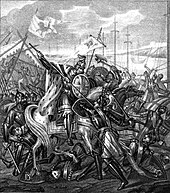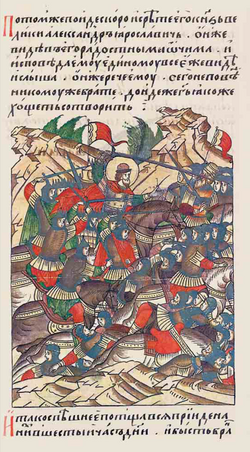|
Battle of the Neva
The Battle of the Neva (Russian: Невская битва, romanized: Nevskaya bitva; Swedish: slaget vid Neva; Finnish: Nevan taistelu) was fought between the Novgorod Republic, along with Karelians, and the Kingdom of Sweden,[2] including Norwegian, Finnish and Tavastian forces, on the Neva River, near the settlement of Ust-Izhora, on 15 July 1240. The battle is mentioned only in Russian sources,[3] and it remains unclear whether it was a major invasion or a small-scale raid.[4][5] In Russian historiography, it has become an event of massive scale and importance.[6] BackgroundPope Honorius III (1216–1227) received a number of petitions regarding new Baltic crusades, mainly concerning Prussia and Livonia but also a report from the Swedish Archbishop concerning difficulties with their mission in Finland. At that time, Honorius responded to the Swedish archbishop only by declaring an embargo against trade with pagans in the region; it is not known if the Swedes requested further help for the moment.[7] In 1237, the Swedes received papal authorization to launch a crusade, and in 1240, new campaigns began in the easternmost part of the Baltic region.[8] The Finnish mission's eastward expansion led to a clash between Sweden and Novgorod, since the Karelians had been allies and tributaries of Novgorod since the mid-12th century. After a successful campaign into Tavastia, the Swedes advanced further east until they were stopped by a Novgorodian army led by Prince Alexander Yaroslavich.[9] Novgorod fought against the crusade for economic reasons, to protect their monopoly of the Karelian fur trade.[10] Russian sourcesThe existence of the battle is known only from Russian sources.[3] The first source to mention the battle is the Novgorod First Chronicle from the 14th century.[11] According to the chronicle, on receiving the news of the advancing Swedish, Norwegian, Finnish and Tavastian fleets, the 20-year-old Prince Alexander Yaroslavich of Novgorod quickly moved his small army and local men to face the enemy before they had reached Lake Ladoga. The chronicle described the battle as follows: 
A 16th-century version of the battle gave plenty of additional details, expanding the conflict to biblical proportions, but otherwise following the earlier described developments.[16] Prince Alexander Yaroslavich was nicknamed "Nevsky" (of Neva) after his first significant victory.[citation needed] Two years later Alexander stalled an invasion of the Livonian Knights during the Battle on the Ice. Despite the victories there were no Novgorodian advances further west to Finland or Estonia. Swedish sourcesThere is no reference to a battle of the Neva in Swedish sources.[17] Situation in Sweden
After the death of King John in 1222, Sweden was in a de facto state of civil war until 1248 when Birger Jarl managed to seize power in the kingdom. Unrest was due to the struggle between those who wanted to keep the old tribal structure,[18] the folkung party, and the king, who was assisted by the church. Folkungs, who were mainly from Uppland, stoutly resisted the centralization of power,[19] taxation of the Swedes of Uppland,[18] and church privileges.[19] They had temporarily succeeded in deposing the king in 1229, but were forced to give in five years later, but were far from defeated yet. Uppland remained largely independent of the king, and its northern areas continued to be in folkung hands. An uneasy truce continued until 1247, when the folkung rebellion was put to an end at the Battle of Sparrsätra and its leader beheaded a year later.  Furthermore, the official Sweden was on the brink of war with Norway ever since the Norwegians' infamous Värmland expedition in 1225.[20] Relations improved only after the Treaty of Lödöse in 1249, which was forged by the newly empowered Birger Jarl.[21] Before the treaty, Norway remained an ally of the folkungs, giving them refuge and providing men and arms. In this situation, it seems unlikely that Sweden could have been able to organize a major expedition against Novgorod. Swedes are not known to have carried out any other military campaigns between 1222 and 1249, making the claims about their forceful appearance at the Neva with Norwegians as their allies seem questionable.[citation needed] TheoriesTaking these facts into consideration, it has been suggested in a recent book aimed at a wide readership,[22] that the Swedish expedition may have been an indirect result of the papal letter in 1237 that was sent to the Swedish Archbishop of Uppsala.[23] The letter eloquently called for a crusade, not against Novgorod, but against Tavastians in Finland, who had allegedly started hostilities against the church. In his defunct position, the king may not have been willing or able to act, but the letter may have provided the frustrated folkungs an opportunity to regain part of their Viking Age glory. Mostly free to act without interference from the king, folkungs would have been able to raise an army of their own, get volunteers from Norway and even assistance from Thomas, the independent Bishop of Finland, who needed to constantly worry about attacks from the east. Instead of Tavastia, this mixed set of interests and nationalities would have headed for the more lucrative Neva and there met its fate at the hands of Alexander.[citation needed] In the possible aftermath of the said battle, the King of Norway approached his Swedish counterpart for peace talks in 1241, but was turned down at the time. However, some recent research has fundamentally questioned the importance of the battle, seeing it as an ordinary border skirmish that was exaggerated for political purposes, thus also explaining its absence from Swedish and other western sources.[24] Additional theories are numerous. Some historians have suggested that the Swedish army was already under the command of the very young Birger Jarl, eight years before his appointment to the position of jarl.[25] It has also been suggested that the suspicious information on Norwegians', Finns' and Tavastians' participation was made up in the 14th century, the time of writing of the First Novgorod Chronicle, when Sweden was in control of Norway, Finland and Tavastia.[citation needed] ConsequencesAll in all, the first known Swedish military expedition against Novgorod after the events at the Neva took place in 1256, following folkungs' demise, peace with Norway and conquest of Finland. If the battle of the Neva had any long-term consequences, it was in Sweden's determination to take over Finland first before attempting to proceed further east.[citation needed] LegacyIn 2007, scholar Janet L. B. Martin wrote: "Novgorod and Sweden were competitors both for dominance over Finnic tribes north of the Novgorod lands and for control over access to the Gulf of Finland. The Swedish attack on the Neva River in July 1240 was one of a long series of hostile encounters over these issues, not, as is sometimes asserted, a full-scale campaign timed to take advantage of the Russians' adversity and aimed at conquering the entire Novgorodian realm. Nevertheless, Alexander's victory there was celebrated and became the basis for his epithet Nevsky."[26] See alsoNotes
References
Bibliography
|
||||||||||||||||||||||||||||
